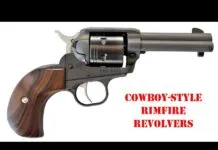The recent introduction of magazine-fed versions of the Remington 870 and Mossberg 590 pump-action shotguns have led to immense interest in the new designs, but we have not jumped onto the mag-pump bandwagon because, in our view, these shotguns are not without some trade-offs. Some of our shooters see nothing wrong with the tubular-magazine-fed shotgun, which can be topped off on the fly by a trained shooter. Others on our team question the balance of the converted shotguns and the loss of the natural pointing characteristics of the tube-fed pumps. (We use the term “converted” as a means of describing the modifications made to existing pumpgun designs).
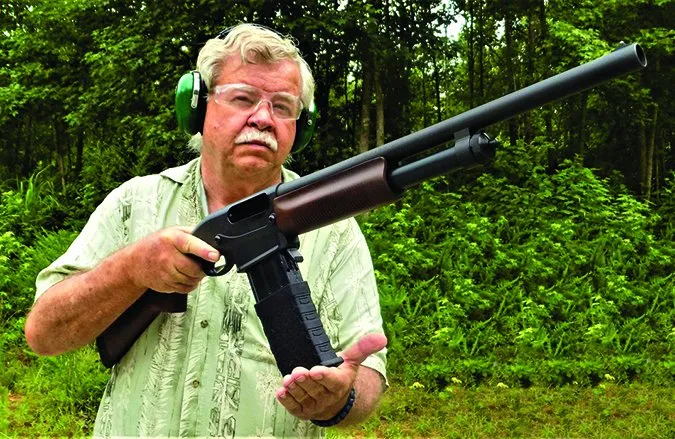
Despite our misgivings, the magazine-fed pump-action shotguns have been at the top of our test list, so we acquired a Remington Model 870 DM and the Mossberg 590M. To make for a broader field of reference, we added two proven tube-fed pump shotguns. The Remington 870 Tactical features Magpul furniture and XS sights, and the Mossberg 590 Tactical has a heat shield and a SpeedFeed Synthetic Stock. Then, to cap it off, we added a Saiga-style JTS M12AK shotgun, a magazine-fed semi-auto. This allowed us to compare two familiar shotguns against the magazine-fed versions of the same shotguns, as well as a previously tested magazine-fed semi-auto style that ranked well. The test was very involved and very interesting.
Why Have New Magazine-Fed Models Appeared?

There have been mag-fed shotguns before, of course, but why are Mossberg and Remington taking this leap now? Our guess: The AR-15 rifle seems at the top of the heap among popular firearms at present, and there isn’t anything wrong with that; the AR-15 is a lot of fun to fire and use. For civilians, however, the shotgun likely remains the best short-range problem solver and also the best home-defense firearm. They are also useful for defense against violent animals. But with millions of ARs being sold over the last 20 years, many shooters have grown accustomed to working with magazines. It seems to us, then, the introduction of magazine-fed shotguns is tied to the popularity of magazine-fed self-loading rifles.

The shotgun offers fast and simple handling and reliability and is simple to use and effective at close range. Shot doesn’t carry as far as a cartridge round, making it less offensive than a pistol or rifle in the case of misses. The problems some find with the shotgun are limited magazine capacity and reloading speed, which the new mag-fed models purport to solve.

The most popular pump-action shotguns, the Remington 870 and Mossberg 500, actually spring from the same primogenitor. Remington’s smooth Model 31 shotgun was deemed too expensive to manufacture, so during the late 1940s, the Remington 870 was developed. The Mossberg also has features related to the Remington 31 shotgun. These designs are proven; there are plenty of accessories, parts, and spare barrels available; and they are easily maintained and operated. For many years, a simple pump-action shotgun with a four- or five-shell capacity was all that was deployed. Today, we have extended magazine tubes and shell carriers for shotguns. Some aftermarket add-ons are high quality, others are not, but few affect function. Modern shooters like to have a greater magazine capacity and favor extended magazine tubes. If you find yourself in what would be an uncommon situation engaging multiple threats that are moving, this capacity could be a life saver. It is good to have all of the gun load carried on the shotgun. Gun belts carrying shotgun shells are heavy and cumbersome and not particularly fast to use. The perceived need for extra firepower is also, we feel, related to the popularity of AR-15 rifles. A shotgun is a different animal and must be looked at in a different manner.

As far as quickly reloading the shotgun, this is needed more in room clearing in Afghanistan than in home defense. But we added a Mesa Tactical side-saddle shell carrier to the Remington 870 tactical and used it during a firing test, and the Mossberg 590 purchased was outfitted with a SpeedFeed stock. The shotgun is reliable, and with a good understanding of the available shotshell loads, they may be versatile. While standard pump-action shotguns are formidable, adding custom stocks and sights are beneficial. If any are essential we cannot say, but many of these, such as the Magpul stock and XS sights, are good to have. Just be certain that any additions to the shotgun do not conflict with reliable operation. Train with the shotgun to master it, and train again after any accessory is added.

Mossberg launched its Mag-Fed 590 pump-action shotgun line in January 2018, and we had occasion to test the Mossberg 590M Mag-Fed Pump-Action 50205 12 Gauge, $535 from BudsGunShop.com, against the other four shotguns. The front of the shotgun is built on Mossberg’s pump-action tactical platform, which is now married to double-stack shotgun magazines in 5-, 10-, 15-, and 20-round counts. The 590M is initially available in two 10-round configurations. Our test gun, the 50205 base model comes with an 18.5-inch-long heavy-walled Cylinder-bore barrel, bead sight, black synthetic stock and forend, matte-blue metal finishes, and a 10-round, double-stack magazine. MSRP for it is $721. The 590M Mag Fed Tri-Rail 10-Round (50206) option features a Tactical Tri-Rail forend with full-length bottom rail and dual side rails for attachment of lights and accessories. It, too, has an 18.5-inch heavy-walled barrel with a 2.75-inch chamber and adds an interchangeable Accu-Choke choke tube system with a Cylinder-bore tube included. The 50206 also has a protective heat shield, Ghost-Ring sight, black synthetic stock and forend, matte-blue metal finishes, and comes with a 10-round double-stack magazine. MSRP is $801. Standard features of the 590M include non-binding twin action bars, anti-jam elevator in the magazine, dual extractors, anodized aluminum receiver drilled and tapped for optics, cleanout magazine tube, and an ambidextrous top-mounted safety. With the included 10-round magazine, these 12-gauge pump-actions have a total round capacity of 10+1.
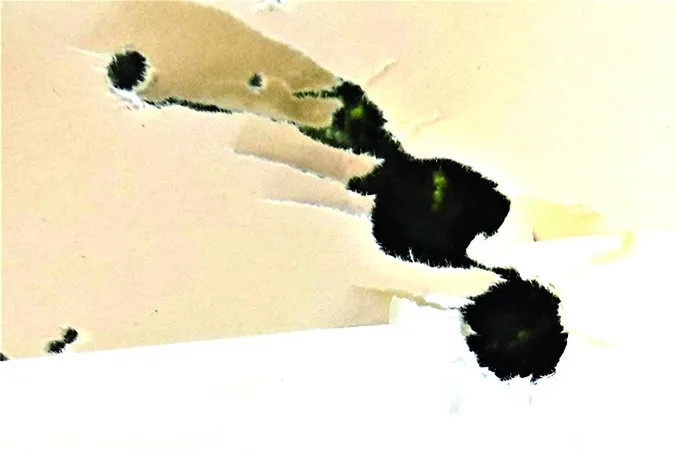
The company’s description of the patented double-stack magazines includes hardened-steel feed lips, over-molded steel shell ramps, and an anti-cant, rounded follower. Other design features include a molded external shell, proprietary self-lubricating polymer magazine body, heavy-duty ASTM-A-228 music-wire magazine spring, a removable floorplate for ease of cleaning, and a black-oxide finish on the steel components. The double-stack magazines are proprietary, which creates a pricing problem, as we learned.
Remington publicly launched its magazine-fed line of pump shotguns in December 2017, pointing out the Model 870 pump-action shotgun has long been a favorite of tactical, home-defense, military, law-enforcement, and traditional sporting shooters, with more than 11 million sold. The new 870 DMs offer 3- and 6-round magazines, and the company touted the magazines’ ability to instantly alternate loads because “invaders in your home don’t wait for you to fill a magazine tube.” Five models were available initially, the least expensive of which was our test gun, the Remington 870 DM Hardwood 81351 12 Gauge, $324, which has been available at that price from BudsGunShop.com recently. The baseline black-synthetic unit, Model No. 81350, has a stock with Super Cell recoil pad, tactical “corn cob” forend, and an 18.5-inch fixed Cylinder bore barrel. MSRP is $529. Another self-defense variation in the line is the 870 DM Magpul 81352, which features a Magpul SGA stock with Super Cell recoil pad, a Magpul MOE M-LOK forend and 18.5-inch Rem Choke barrel with an extended ported tactical choke, an XS steel front sight and XS tactical rail/Ghost Ring rear sight. MSRP for it is $799. The 870 DM Tactical/Predator 81354 has an OverMolded ShurShot thumbhole stock, MSRP $799; the 870 DM Tac-14 (81348) has a Shockwave Grip, Magpul Forend, and a 14-inch barrel (MSRP $559); and the 870 DM Tactical (81360) has a pistol grip buttstock, “corn cob” forend, and an extended ported tactical choke (MSRP $799).
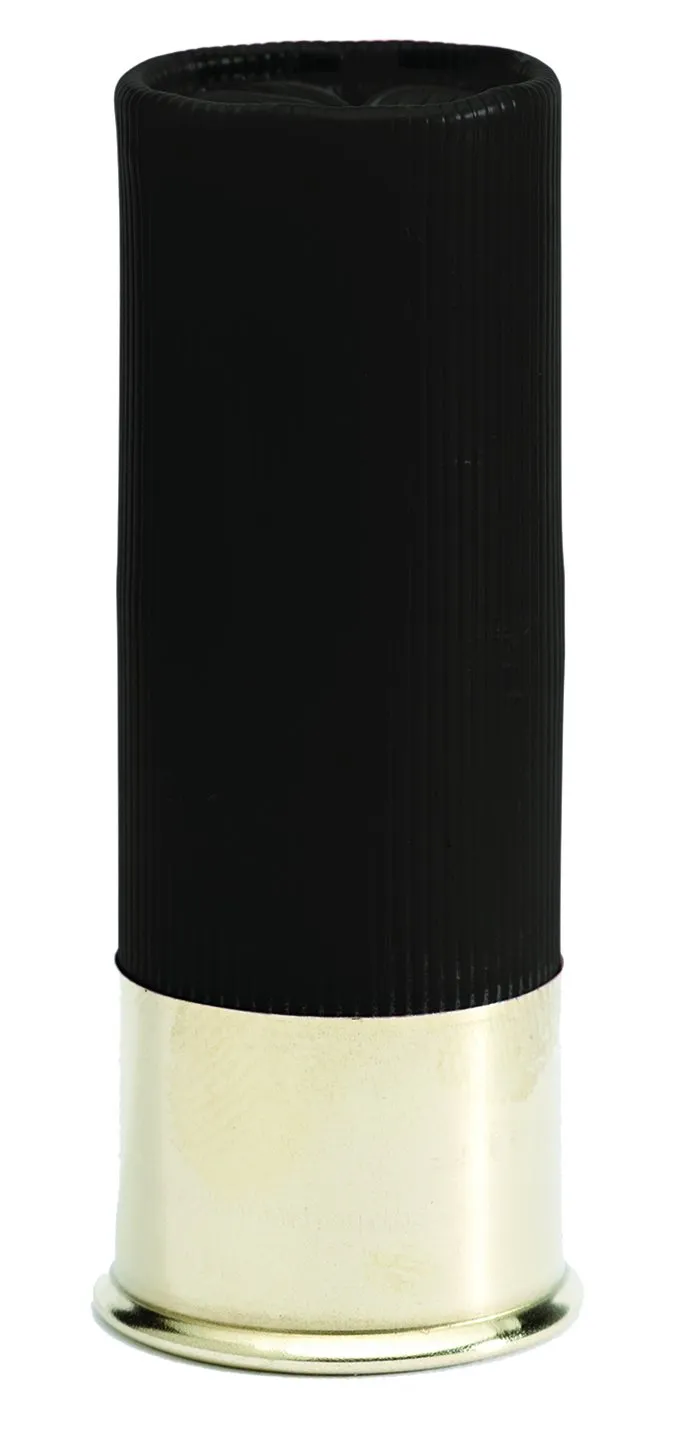
The JTS M12AK Semi-Auto Shotgun, an AK-style scattergun, $450, from an Academy Sports & Outdoors retail store, represents a box-fed version that has lead the way in magazine shotguns for a long time. We felt it would be good to test the type against our new magazine-fed pump action shotguns. This is a Chinese-made AK-47-type gas-operated self-loading shotgun with a five-round detachable box magazine. Unlike the other two magazine-fed shotguns, the JTS is supplied with two magazines. The receiver features a Picatinny rail. There is a four-position adjustment for the gas system that should allow firing light loads to heavy loads. The stock and forend are standard AK-47 black-synthetic types. The sights are not traditional shotgun sights, but are instead a front post and an adjustable AK-47-type rear sight. In common with all other shotguns tested save the Mossberg 590M, the JTS accepts both 2.75- and 3-inch shells.
Our two tube-fed pumpguns were the Remington Model 870 Express Tactical Magpul 81209, $729and the Mossberg 590 Tactical Shotgun Heat Shield SpeedFeed Synthetic Stock 50665, $480, both of which had specialty buttstocks.
We used six loads during the shooting evaluation. We relied primarily on light birdshot loads during the evaluation to mitigate the effects of recoil and for economy and convenience. These included Estate Cartridge No. 7 birdshot ($5.43/25 from BudsGunShop.com), Winchester’s AA birdshot ($10.75/25 from LuckyGunner.com), and Fiocchi’s No. 8 birdshot ($8.07/25 from SportsmansGuide.com) We fired at least 100 light loads in each shotgun during the firing test.
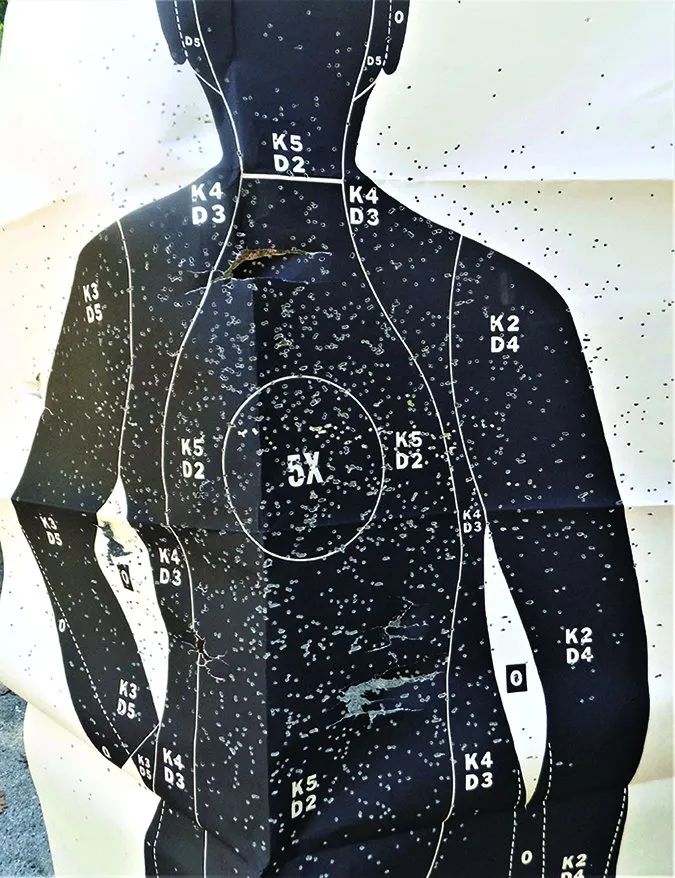
We also used buckshot on several combat courses, firing at 7, 10, and 20 yards. We also fired twenty rounds of each of the following loads in each shotgun: Federal 9-ball 00 buckshot LE13200 ($4/5 shells from AmmoDepot.com) and Hornady’s American Gunner buckshot ($7.38/10 shells from TargetSports.com). We also fired each shotgun for accuracy with ten shells using Fiocchi’s full-power Aero slug ($8.10/10 shells from VenturaMunitions.com). Individual raters also supplied a number of mixed loads left over from previous testing.
The four pump-action shotguns tested all have the same takedown. Unscrew the barrel nut that rides on the magazine tube and remove the barrel for cleaning. The Mossberg 590 has two rail attachments. The magazine-fed shotguns have wisely not modified this feature. The four pump shotguns, then, are equal concerning maintenance. The fifth shotgun, the JTS AK-type, is also simple, but with the added complication of a gas-operated action. Press a button on the back of the dust cover to remove the dust cover/action cover. Remove the recoil-spring assembly then bolt-carrier assembly. There is plenty of room to clean the barrel from the rear. Considering the difficulty in removing the bolt from a pump-action shotgun, the AK system has much merit. Here’s more about each shotgun individually:
Mossberg 590M Mag-Fed Pump-Action 50205 12 Gauge, $530
GUN TESTS GRADE: D
We liked the Mossberg when examining the piece in dry fire and based on the magazine design. The magazine does protrude more than the Remington, but it holds ten shells. The shotgun did not function as well as the Remington DM or the tube-feds. We would not buy this shotgun at this time.

| ACTION TYPE | Manual pump action; 2.75-in. chamber |
| OVERALL LENGTH | 39.5 in. |
| OVERALL HEIGHT | 10.3 in. |
| CAPACITY | 10+1 |
| WEIGHT UNLOADED | 7.8 lbs. |
| WEIGHT LOADED | 8.7 lbs. |
| BARREL | 18.5-in. heavy-wall matte-blued steel |
| CHOKE | Cylinder bore |
| BUTTSTOCK | Synthetic with recoil pad |
| BUTTSTOCK LENGTH OF PULL | 13.87 in. |
| FOREND | Grooved synthetic |
| SIGHTS | Bead front |
| TRIGGER PULL WEIGHT | 6 lbs. |
| WARRANTY | 2 years |
| TELEPHONE | (800) 363-3555 |
| WEBSITE | Mossberg.com |
| MADE IN | USA |
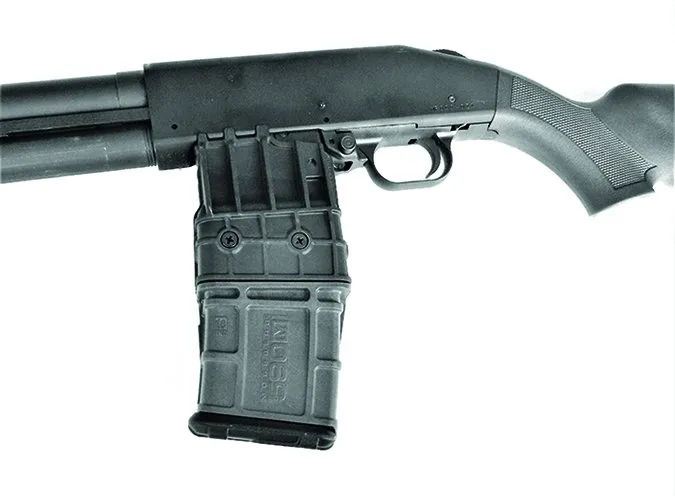
This was a recent price at BudsGunShop.com. Approaching the Mossberg and the Remington shoot out, we found adherents of each that are adamant their choice is the better shotgun. These are very experienced shooters. This means that they have practiced to the point that one shotgun or the other best suits their style and proficiency, and they will prefer the action or the safety design or one shotgun over the other. With the introduction of the Mossberg 590M and Remington 870 DM, we might expect the choice to be more of the same, with the shotguns being adopted straight down the line by Mossberg or Remington fans. But this isn’t happening, for several reasons. One, the Remington magazines are scarce as of this writing. Second, the magazine attachment is different between the Remington and Mossberg. Sometimes the first shotgun that we own is the one we live with — or decide it isn’t the one for us. But given two reliable systems, a single feature may sway the user. The Mossberg safety sways some. The Mossberg magazine attachment may sway others.
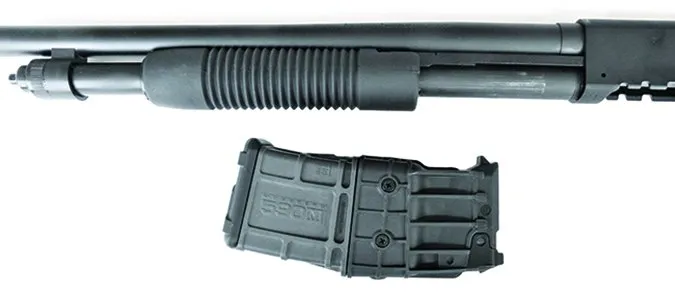
Finish and accessories are not as important as how the shotgun performs. The Mossberg 590M is a heavy-barrel heavy-duty version of the Mossberg 500 shotgun. This 590M is not supplied with a barrel heat shield. This 590M, unlike the tube-fed 590 20-inch-barrel version tested, did not have the two barrel-band attachments the 590 is known for. (Going forward, we’ll designate the magazine version as the 590M and the tube-fed as the 590T, even though the latter isn’t an official designation.)
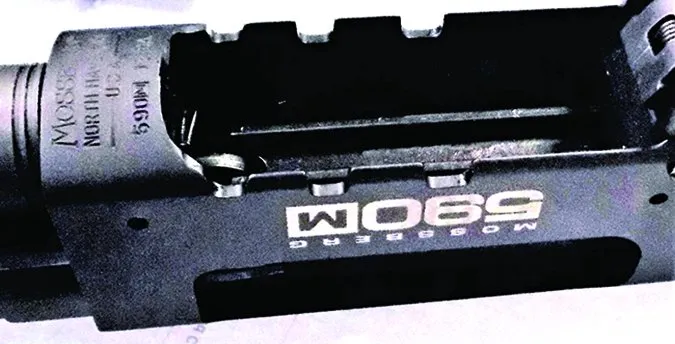
The finish on the 590M is plain matte black and the stocks are synthetic. The sights are a simple bead-front type. The white-outline markings on the receiver look cheap in our opinion, but function isn’t affected. The 590-series is a good choice for the introduction of the magazine-fed Mossberg compared to the lighter Model 500-series build. The safety is mounted on the tang, making it friendlier than Remington to left-handed shooters. We should also note that Mossberg catalogs a left-handed tube-fed shotgun, the Mossberg 590A1 9-Shot 59815, but we have never seen one.
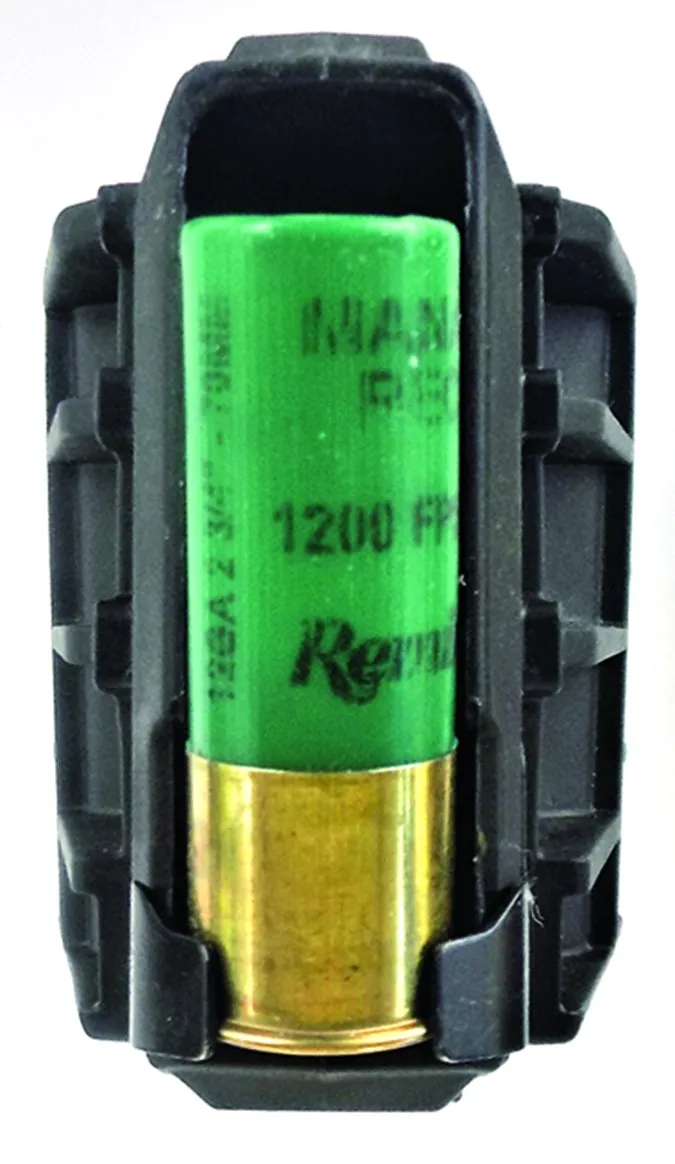
The shotgun’s action seemed smooth, and the dual extractors provided smart removal of spent shells. The bead front sight was the same as the Remington DM’s front sight and provided a simple neat system for quickly getting on target. Part of aiming a shotgun is by feel and looking down the barrel, and to be accurate, the eye must consistently hit the stock and align with the bead. Felt recoil seemed less than the Remington DM with the slug loads and only slightly more with the other loads. The 590M is fitted with a plastic trigger housing, which we did not like, but so is the 870 DM.
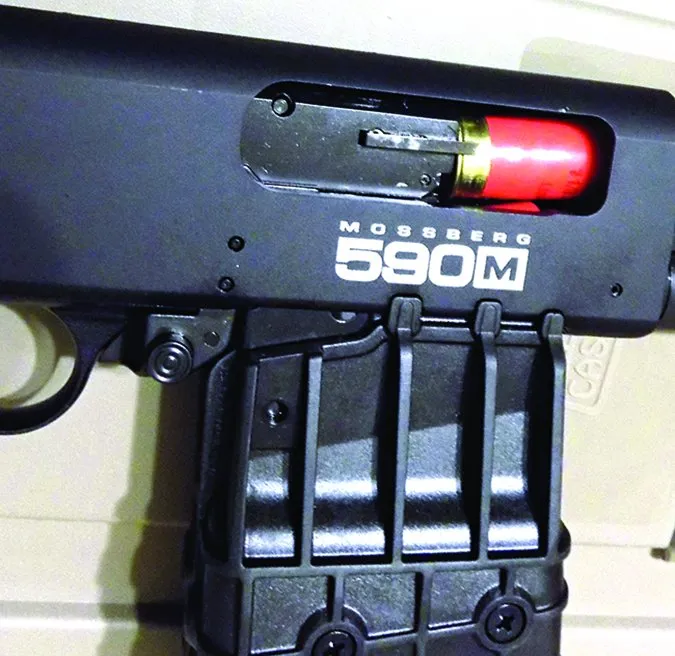
The real difference between the shotguns was in the Mossberg feed device. The 10-round magazine of the Mossberg is a dual-column feed type. It was easy enough to load, although the last few shells required extra effort. The Remington 870 DM magazine’s was more difficult to load. We could press the shells into place with the Mossberg and load 10 in approximately the time it took to load and press a shell to the rear and load six with the Remington. The Mossberg has more of the look of a purpose-designed shotgun than a conversion, as in the 590M’s receiver has been redesigned more extensively. While the magazine is larger and heavier, loading the Mossberg 10-shot magazine immediately gives the shooter a greater capacity than even an 8-shot tubular-fed magazine. The weight balance is different, too, and while the raters are split on this, the weight of the Mossberg seems to limit recoil because of sheer mass. So does the heavy barrel of the 590M.
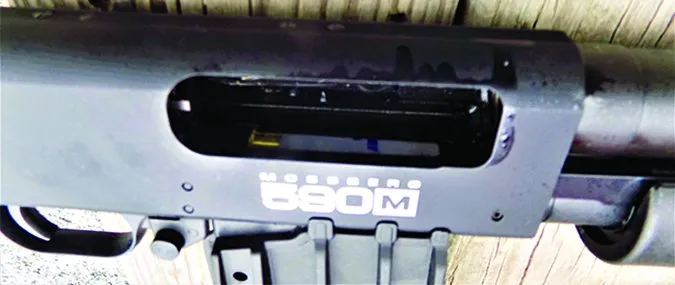
The magazine has a lip on the front that is angled in and the magazine is rocked in to load, and it never moved after it was locked in. The Mossberg locks in tight with the proper action and isn’t difficult to remove. While the Remington’s failure to feed when a magazine was not locked in place may be due to the shooter’s mishandling, we never mishandled the Mossberg as far as locking the magazine in place. We did, however, have other problems. The evaluation was limited to the 10-round magazine supplied with the shotgun, so we cannot comment on the 20-round magazine, save to say they are heavier and the balance point may be different. As for durability, we dropped the Mossberg magazine, and the Remington as well, several times on the range. Neither cracked or discharged their loads. We also left each loaded for a full month and found the magazines did not show any problems. Still, from an engineering standpoint, we recommend keeping the Mossberg downloaded to nine rounds. Consulting a source who designs and sells industrial springs, the primary rater confirmed that when a spring is at maximum tension — as with a 10-shell load — downloading one shell lessens the load more than 10 percent. For what we know now, the Mossberg and Remington magazines may end up being as durable as Glock magazines, but it is best to err on the side of caution. Also, the Mossberg 10-round magazine protrudes more than the Remington and may snag. Mossberg also offers a 5-round magazine if that’s an issue for you. We did not test any of the other Mossberg magazines because they are quite pricey, and that is a drawback. The magazines, we believe, are overpriced, and this is going to hurt the Mossberg.
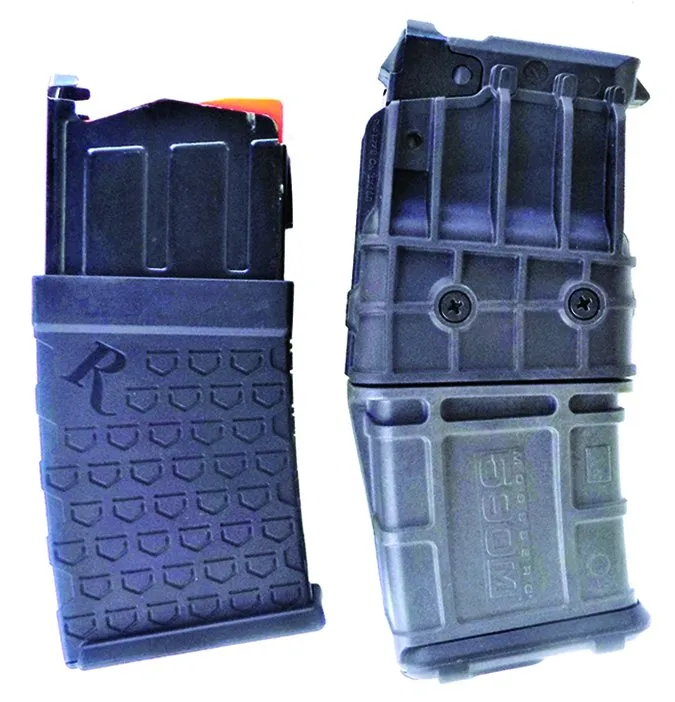
As of July 20, 2018, GunmagWarehouse.com had the 20-round Mossberg 590M magazine for $125 and the 15-round magazine for $120. The 10-round magazine is $95. This compares to the Remington’s 6-round magazine at $38. The magazine of the Mossberg weighs about 1.6 pounds versus 9 ounces for the Remington, with 40% less capacity for the Remington. The Mossberg magazine is more complex, yes, but the Mossberg standard magazine costs more than twice as much as the Remington. This means a lot in institutional sales. On the plus side, the Mossberg magazines were readily available at this date.
When it came to shooting, the smooth action of the Mossberg developed a catch. The magazine system we liked in dry fire let us down in live fire. When actually loading and firing the Mossberg, the forend seemed to bind approximately 2 inches into travel. The first shells were the Estate birdshot loads, with which we had four failures to feed (actually, the shell failed to chamber with the first magazine). We struck the bottom of the magazine and attempted to get the Mossberg going. We had to remove the magazine. Most often, a shell flipped out as the magazine was removed. The shells were failing to strip from the magazine. We double checked the attachment — apparently the magazine could not be locked in incorrectly — and tried again with the same results.
After changing to Winchester and Fiocchi shells, the problem disappeared as far as feeding but the catch in the action did not. This only occurred when firing shells, not when doing dry fire. With buckshot, the problem seemed less pronounced. These problems did not occur with the Remington 870 DM. While we found the magazine design and attachment superior to the Remington during the initial evaluation, the problem of changing the operation of the shotgun from feeding from a tube to a magazine, without a shell lifter and using a cocking block, seems not to have translated well. The day after the initial test, the primary rater sprayed the 590M with lubricant and loaded a magazine with a mix of birdshot and buckshot. The problem reared its head again, with two shells ejected, a tie up, then we fixed the problem and it returned.
Our Team Said: We were unhappy with the malfunctions. While the Mossberg may not have liked these particular shells, the Remington had no such problem. The Mossberg misfed with several types of shells. The balance of the Mossberg is affected by a fully loaded magazine that is quite heavy, and the shotgun should be fired and swung on target with a natural feel. But then, we do have 9+1 shells on tap. In the end, the Mossberg had a catch at a certain spot in the action we did not like, and there were feed issues that should not have occurred. We would not buy this shotgun.
Remington 870 DM Hardwood 81351 12 Gauge, $324
GUN TESTS GRADE: A- (Best Buy)
The Remington 870 DM is the least-expensive shotgun tested, yet it may be the best suited for home-defense use. Handling is little different from a standard Remington 870, and the box magazine didn’t affect balance as we thought it might have. The modification to the receiver results in a 0.75-inch-taller receiver. The magazine is rugged and reliable, if a bit difficult to load compared to the Mossberg. We liked the 870 DM. It is a good buy and should serve as well as any other pump-action.

| ACTION TYPE | Manual pump action; 3-in. chamber |
| OVERALL LENGTH | 38.5 in. |
| OVERALL HEIGHT | 8.5 in. |
| CAPACITY | 6+1 |
| WEIGHT UNLOADED | 7.5 lbs. |
| WEIGHT LOADED | 8.4 lbs. |
| BARREL LENGTH | 18.5 in. |
| BARREL | Steel |
| CHOKE TUBES | None |
| BUTTSTOCK | Wood |
| BUTTSTOCK LENGTH OF PULL | 14 in. |
| FOREARM | Wood |
| SIGHTS | Front bead |
| TRIGGER PULL WEIGHT | 6.4 lbs. |
| WARRANTY | 2 years |
| TELEPHONE | (899) 243-9700 |
| WEBSITE | Remington.com |
| MADE IN | USA |
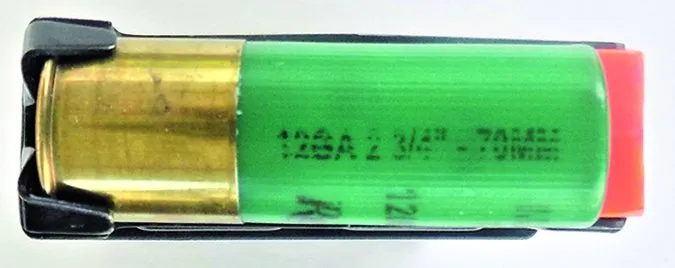
The Remington is $200 less expensive than the Mossberg 590M and $50 or more off the price of its stablemate, the black synthetic 870 DM 81350, which widely sells for around $380. The action is typical Remington, smooth and easy to rack. The action was smoother than the Mossberg, we thought. We obtained a wood furniture Remington 870 DM, the only traditional stock shotgun of the test. It worked well for the test as we had a similar 870 shotgun with a conventional tube magazine to test against it.
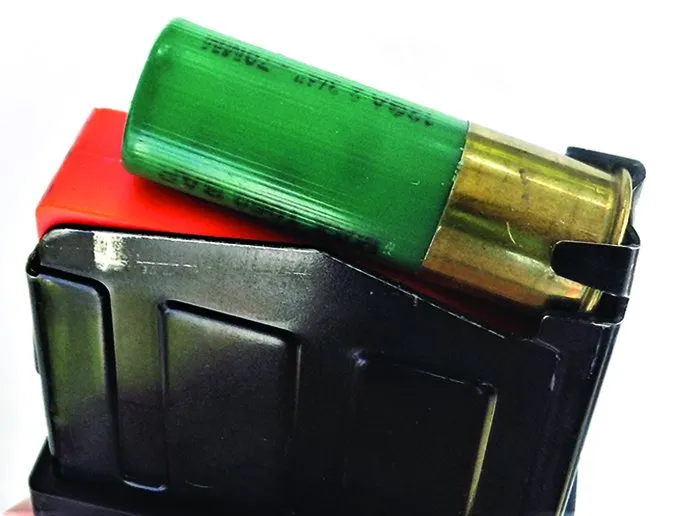
The Remington features a push-button safety in the rear of the trigger guard. The receiver is all steel. The barrel is the same 18.5-inch length as the Mossberg and likewise is a plain-barrel shotgun with a bead front sight. The fit and finish are the same as most Remington shotguns, credible to good. This shotgun was smoother than the Remington 870 Tactical we tested alongside the other shotguns. The 870 DM’s magazine tube, like the 590M, is a dead issue. It is simply there to give the forend and action rails something to run on. The Remington 870 DM will chamber 3-inch shells, which the Mossberg 590M does not. This may be important to some but scarcely matters in home defense. If used with heavy slugs for animal defense, the extra chamber length does matter. The DM receiver is 0.75 inch taller than a similar 870 tube-fed action as a result of the modifications to accept a detachable magazine.
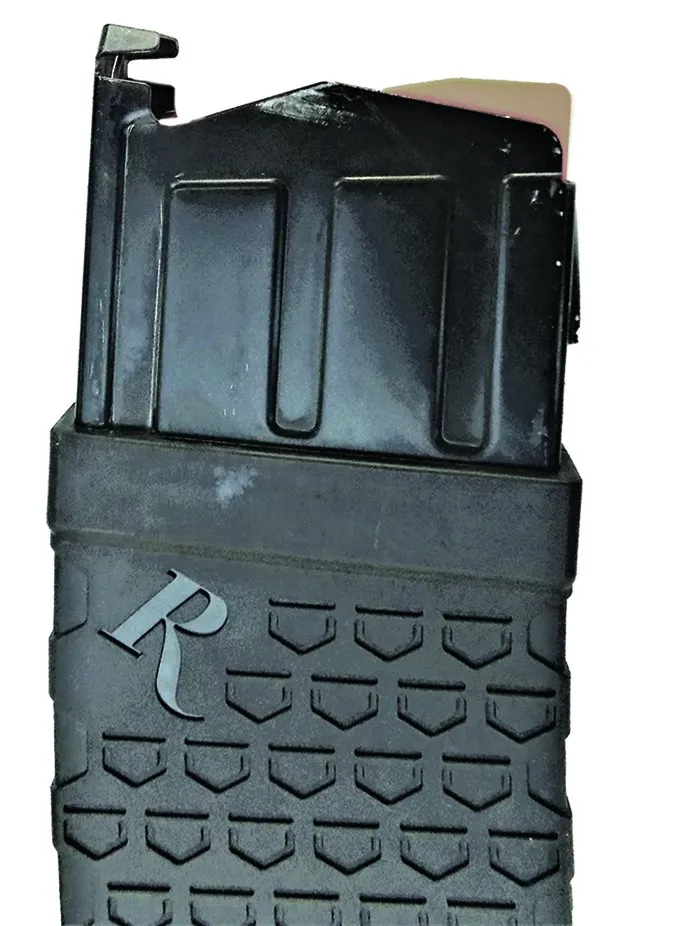
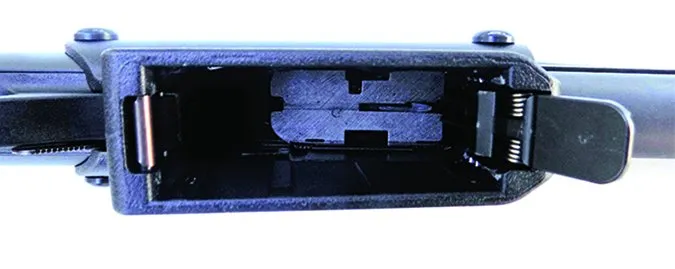
As far as reliability, the Remington 870 really made the Mossberg 590M look bad. There was no question the piece was reliable, with every shell functioning perfectly. The 870 DM handled more quickly than the Mossberg. When racking the action, some shooters allowed the weak-side arm to contact the magazine, but we were able to work around this. We also had this occur with the Mossberg. The bottom line is that the Remington came out of the box shooting and never stuttered.
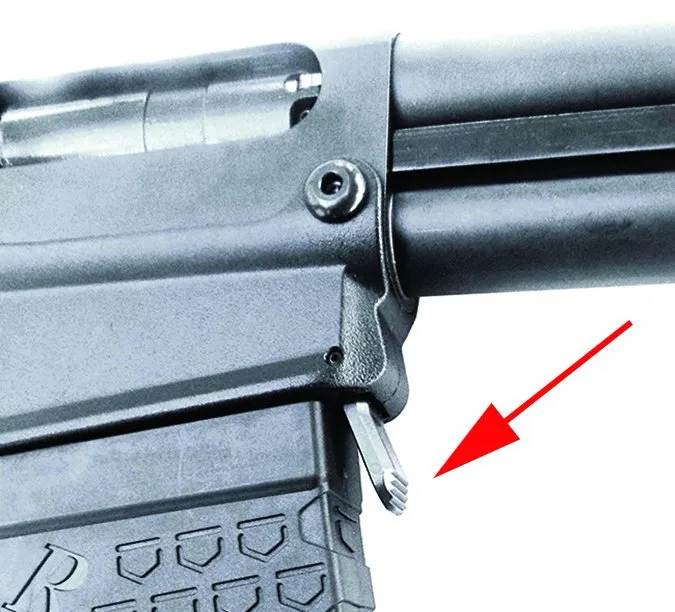
The Remington magazine attachment extends below the receiver. The Mossberg 590M magazine is released by an ambidextrous button and then rocks back into the receiver. The Remington magazine must be pulled out and it isn’t quite as fast to replenish. The Remington release is ambidextrous since it is in front of the magazine. One of our raters came up with an interesting technique. He fired the 870 DM empty, and with the hand fully back on the forend, he slipped his hand to the magazine, pulled it out, and slapped another in. On the other hand, another rater was placing the 870 DM in his truck and bumped the release, jostling the magazine out of battery. But the bulkier 590M is more difficult to stow away. The 870 DM suffered a single failure to feed when it was discovered the magazine was not completely locked in — shooter error.
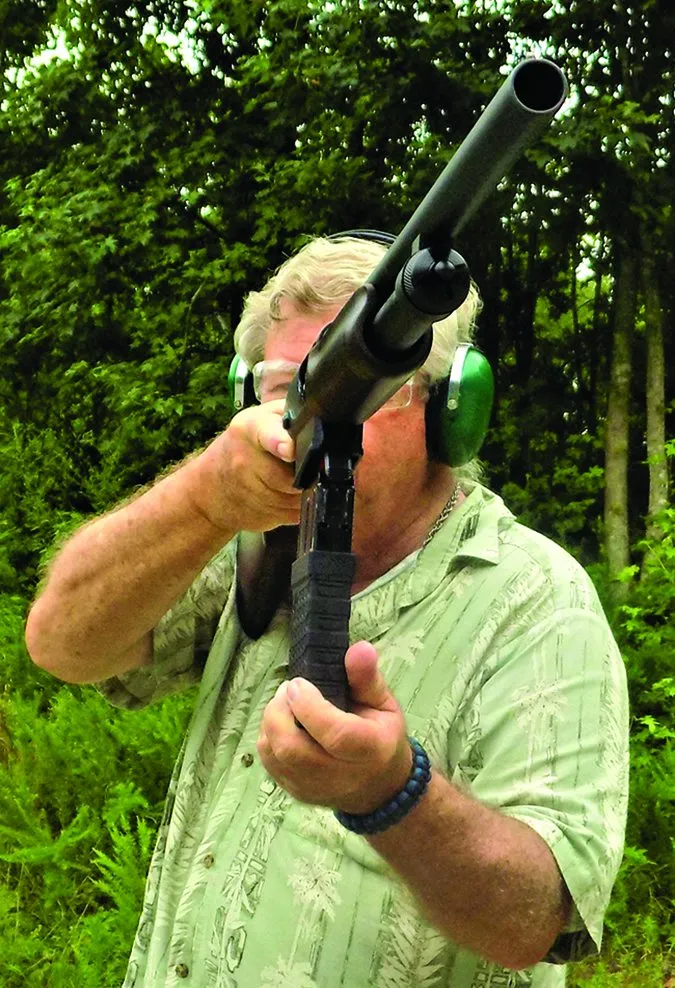
With slugs, each of the bead-sighted shotguns fired a three-shot group of 3 inches or so at 25 yards, so nothing to separate them from there. Comparatively, the Remington Tactical with XS sights fired groups of less than 4 inches at a long 50 yards. Buckshot patterns were similar with no clear winner. But we could deliver accurate fire easier with the Remington 870 DM. The first few shots will matter most in home defense, defense against large animals, or area defense.
Our Team Said: We really liked the Mossberg 590M’s magazine set up, but at the range where it counts, the 590M was not as smooth as the 870 DM. As far as magazine-fed versus tube-fed shotguns — at this point in the mag-fed guns’ development, we prefer the tubular-fed shotguns below.
Remington Model 870 Express Tactical Magpul 81209 12 Gauge, $729
GUN TESTS GRADE: A-
The 870 Tactical Magpul is a good shotgun, but we question any advantage over the standard Remington shotgun for home defense. We liked the Tactical’s ability to take choke tubes. You may also add a red dot on the XS sight rail.

| ACTION TYPE | Manual pump action; 3-in. chamber |
| OVERALL LENGTH | 39 in. |
| OVERALL HEIGHT | 5.25 in. |
| CAPACITY | 6+1 |
| WEIGHT UNLOADED | 7.5 lbs. |
| WEIGHT LOADED | 8.3 lbs. |
| BARREL | 18.5 in. |
| CHOKE TUBES | Remington, Cylinder bore |
| BUTTSTOCK | Black Synthetic Magpul |
| BUTTSTOCK LENGTH OF PULL | Adjustable 12.5 to 14.5 in. |
| FOREARM | Synthetic Magpul |
| SIGHTS | XS Ghost Ring rear, front post Picatinny top rail |
| TRIGGER PULL WEIGHT | 6.5 lbs. |
| WARRANTY | 2 years |
| TELEPHONE | (800) 243-9700 |
| WEBSITE | Remington.com |
| MADE IN | USA |
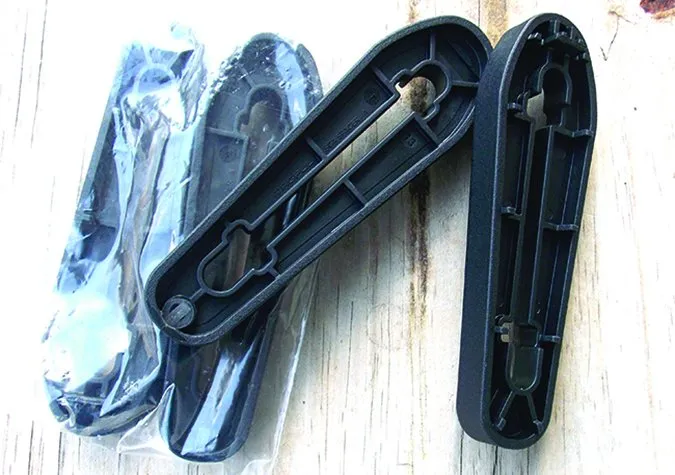
This particular model is no longer cataloged on the Remington website, but we found several units online. This price is from NagelsGuns.net. A current unit with Magpul furniture is the 81192 model number, which lists for $565. But it lacks the breaching tube, the top rail, and the XS sight package. The 870 Tactical 81209 we tested features a Magpul stock with an adjustment for length of pull, and there are also optional cheek risers. If you use a red-dot sight, the cheek riser is especially welcome. The Magpul forend has a feature that prevents slippage of the hand when racking the action. This furniture increases the efficiency of the shotgun in most types of shooting. The particular geometry of the Magpul stock makes for excellent fit.
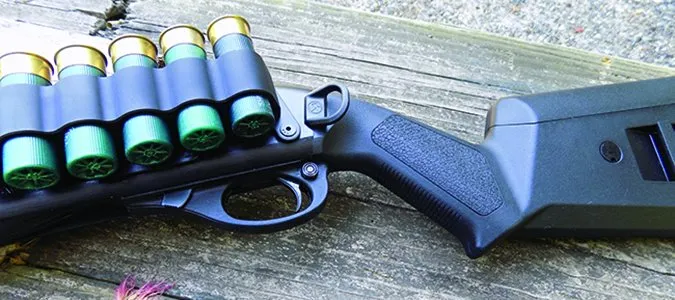
The Remington features a muzzle brake with a toothy edge. This removable brake allows the use of Remington type shotgun chokes. This is an advantage for those wishing to stretch the range of the shotgun. We tested the 870 Tactical with the supplied Cylinder choke tube.

The 870 Tactical is well equipped. The greatest addition to the 870 Tactical, in our opinion, was the XS Ghost Ring sight. This sight is very fast and makes for excellent speed at a slightly longer range. Accuracy with slugs was noticeably increased with this sight. The XS sight includes a rail that accepts a combat optic. We mounted a TruGlo red dot to the 870 Tactical at one point with good results. The Remington shotgun’s Ghost Ring XS sight may be added to nearly any shotgun with a drilled-and-tapped receiver, better, with a Picatinny top rail already installed. The bold front post is an excellent feature. The magazine holds six shells versus the four-shot tube of the standard 870. Also, we added a six-shot Mesa Tactical Sureshell Polymer Carrier 94740 to the receiver (100-022-971WB, $36 at Brownells.com). While the magazine capacity was not increased, the shotgun did have 12 rounds on tap (or 13 with one in the chamber) all carried on the shotgun.
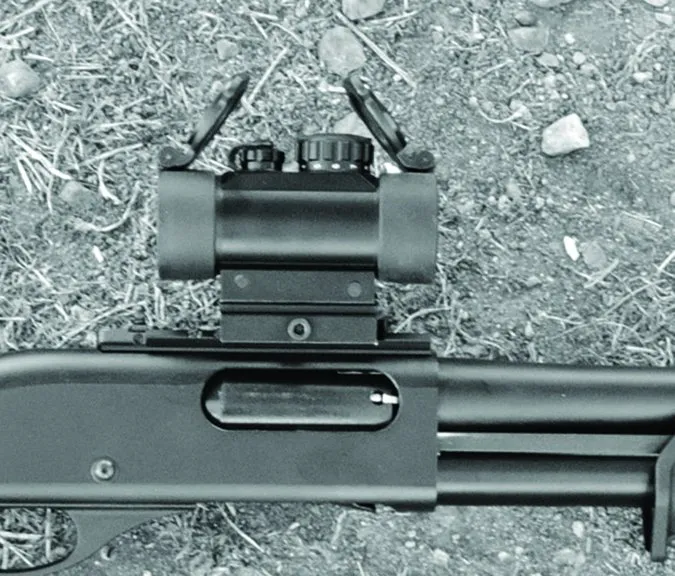
The 870 Tactical was used by a senior rater who gave it good marks; however, some raters short-cycled the shotgun. It may have been a different feel in the Magpul forend, but the same raters did not short-cycle the Remington 870 DM. There were bright spots on the action rails. Perhaps we wore a burr off. In any case, the Remington 870 Tactical Magpul gave excellent results. Firing quickly and emptying the magazine, we quickly dropped a shell from the carrier into the chamber and another into the magazine and were back in business. This is a viable option.

This brings up interesting tactical points concerning the tube-fed versus the magazine-fed shotguns. Perhaps these questions were not resolved, but we have a good idea of the advantages of each type. When firing the pump-action shotgun with tubular magazine, you may top off the magazine as you go with a shell or two with the weak-side hand. In this manner, the shooter may fire one or two shells and immediately top off the magazine. Another advantage is carrying slug loads to insert into a tube magazine. You may keep the tube downloaded one shell and quickly load a slug into the magazine, hit the bolt release, and chamber and fire a slug if need be. Of course, loading alternating buck and slug loads may be done with either magazine type, detachable or tubular. We prefer the tubular-fed magazine. In short, the tubular magazine is better for staying in action; the magazine-fed shotgun is better for immediate reloads after you empty the shotgun.
Our Team Said: This shotgun provided excellent versatility with its Magpul stock and forend. However, perhaps this isn’t for everyone as a couple of the raters short-cycled the shotgun and others did not. The Magpul stock is comfortable. We liked the Ghost Ring aperture sights for slug use and fast shooting at longer ranges. They were not necessarily an advantage over the humble bead in hallway-length fast shooting, but they had it all over the AK-type shotgun’s sights.
Mossberg 590 Tactical Shotgun Heat Shield SpeedFeed Synthetic Stock 50665 12 Gauge, $480
GUN TESTS GRADE: A
The action is smooth, tight, and reliable. Feeding was very smooth. The heavy 20-inch barrel provided excellent recoil control, the best of the test. Pattern tightness was the best of the test with some buckshot loads. The magazine capacity is sufficient, and with the SpeedFeed stock, the Mossberg had sufficient on-board capacity. The 590 gave us confidence and was the only shotgun tested without any type of malfunction.

| ACTION PUMP | Manual pump action; 3-in. chamber |
| OVERALL LENGTH | 41 in. |
| OVERALL HEIGHT | 3.6 in. |
| CAPACITY (2.75 in.) | 8+1 |
| WEIGHT UNLOADED | 7.25 lbs. |
| WEIGHT LOADED | 8 lbs. |
| RECEIVER | Dual extractors, twin action bars; drilled & tapped |
| BARREL | 20 in. long; matte-blued heavy-wall steel; heat shield |
| CHOKE | Cylinder bore |
| BUTTSTOCK | Black synthetic SpeedFeed stock; 4-shell capacity |
| BUTTSTOCK LENGTH OF PULL | 13.9 in. |
| BUTTSTOCK DROP AT COMB | 1.5 in. |
| BUTTSTOCK DROP AT HEEL | 2.125 in. |
| FOREND | Black-ribbed synthetic |
| SIGHTS | Front bead |
| TRIGGER PULL WEIGHT | 6 lbs. |
| SAFETY | Ambi tang mounted sliding button |
| WARRANTY | 2 years |
| TELEPHONE | (800) 363-3555 |
| WEBSITE | Mossberg.com |
| MADE IN | USA |
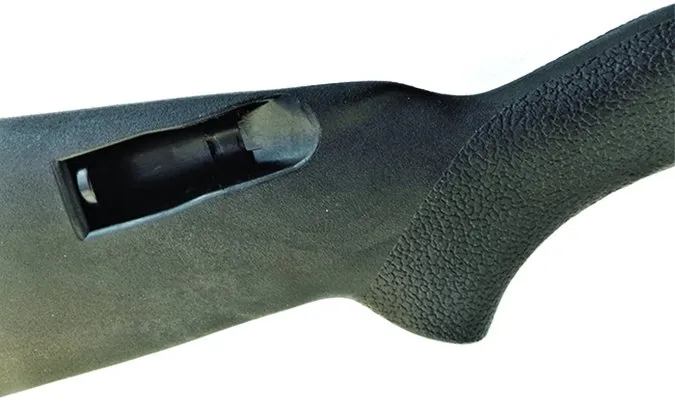
This shotgun was purchased from SCGunCo.com for the price listed. This is the 20-inch-barrel Mossberg 590T with bead front sight and 8+1 capacity. The 590T has two fewer shells in the magazine than the 590M and two more than the Remington 870 DM. Reliability of the Mossberg extended-tube magazine was faultless.
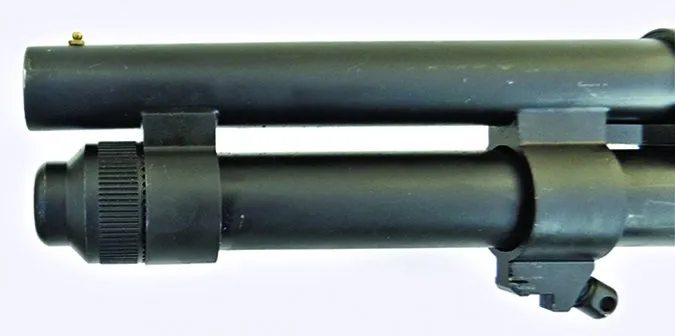
We made several observations with the Mossberg 590 fully loaded. Some felt the shotgun was muzzle heavy with the full load of shells, but then this is also a heavy-barrel shotgun. But a point that cannot be ignored is that a fully loaded shotgun with an extended magazine does have a forward weight bias. This weight bias is most noticeable with the 590T. The Remington 870 DM with its magazine weight centered under the action never presented this bias. Accordingly, some felt the DM was the best-balanced and fastest shotgun to use. However, a standard 4-shot-magazine-tube 870 used as a control was even better balanced. This makes an important point for the 870 DM and its balance.

The Mossberg 590T’s finish is better than the 590M tested alongside of it. The action is smooth, with a tighter feel than the Remington. The shotgun never stuttered, and while the difference was small, it seemed to give the best groups with buckshot loads. The 590T was fast to load from the SpeedFeed stock, allowing the shooter to quickly grab two shells from one side and then two from the other as shells were expended. We liked the Mossberg’s total of 12 rounds on tap, and it was what spurred us to add the Mesa Tactical Sureshell Polymer Carrier to the Remington 870T.

This is the heaviest pump-action shotgun tested, but we gave it no demerits in the action movement and handling. The SpeedFeed stock’s recoil pad was effective. The forend gave good purchase as we racked the slide and burned plenty of powder. This simple forend was rated the best of the test by most raters. We liked the dual barrel attachment of the 590T, as no other shotguns had this because it was deleted on the 18.5-inch-barrel 590M. The ability to mount a bayonet was interesting, but not something we foresee needing. The heat shield was appreciated in long firing sessions.
Our Team Said: This is the shotgun we would prefer if we had to bet our life on it.
JTS M12AK Semi-Auto Shotgun 12 Gauge, $450
GUN TESTS GRADE: A-
The JTS shotgun worked fine and was accurate enough for short-range hunting with slugs, mostly due to its good sights. We did not like a shell sticking in the chamber, but it did not repeat. While the shotgun was generally successful in the test, it does not handle as quickly as the conventional pump-action shotguns. The shotgun features a rail for mounting red-dot sights.

| ACTION TYPE | Gas-operated self-loading, 3-in. chamber; 4-position adjustable gas system |
| OVERALL LENGTH | 39.37 in. |
| OVERALL HEIGHT | 5.5 in. |
| CAPACITY | 5+1 |
| WEIGHT UNLOADED | 8.5 lbs. |
| WEIGHT LOADED | 9.3 lbs. |
| RECEIVER | Blued stamped steel, PIcatinny top rail |
| BUTTSTOCK | 13.5 in. LOP, black synthetic AK style |
| FOREARM | Black synthetic |
| BARREL | 18.7 in. long, blued steel, Chrome-lined barrel |
| CHOKE TUBES | Rem Choke compatible |
| SIGHTS | Open adjustable rear; post front |
| TRIGGER PULL WEIGHT | 7 lbs. |
| WARRANTY | 1-year limited warranty |
| TELEPHONE | (281) 723-9627 |
| WEBSITE | JTSGroup.us |
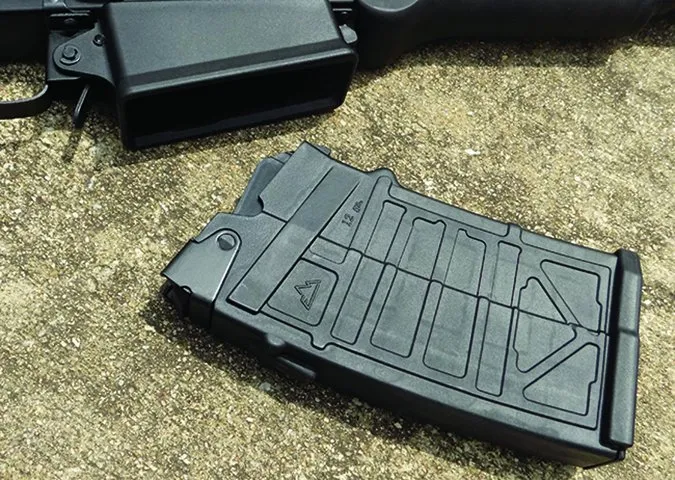
The first thing you notice is that the piece is heavy, the heaviest shotgun tested. It doesn’t really handle like a shotgun. The natural point isn’t good. The JTS handles like an AK, not an 870, but then that is the design intent. Anyone who is an AK fan might love this shotgun and groove into it more than we did. We were evaluating shotgun performance, and in fast-moving scenarios, it suffered compared to the other shotguns. A feature we did like is that the JTS accepts Remington-style choke tubes. This gives the shooter greater versatility. The rifle-type sights slowed us down in combat drills compared to the simple front beads or the Remington Tactical’s XS sights.

To load the JTS shotgun, seat the magazine and rack the cocking lever. The standard AK-type safety lever proved positive in operation. Some are too tight; the JTS safety lever had a good balance and locked securely but wasn’t difficult to move to the Safe position. We fired the shotgun with the same shells as the other shotguns, and the JTS was nearly 100% reliable. We kept the gas port set at medium, which allowed use with a variety of shells. It seemed to work as designed.
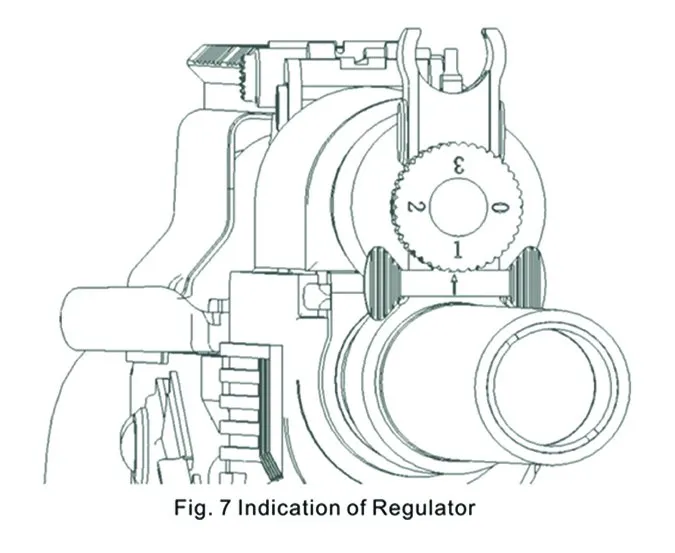
Because the shotgun worked at this gas setting, we made no attempt to fine-tune gas operation for each load, something we’d recommend the end user probably should do. When the gas vent is set properly for the particular light or heavy load, the shotgun is reliable. However, we had a problem with the JTS shotgun. A single Federal buckshot shell stuck in the chamber. The shotgun fired, and the shell did not eject. We removed the magazine, and it took considerable effort to rack the bolt and remove the shell. This was inexplicable and did not repeat. The magazine release worked well enough, and the JTS design was faster to reload than the Remington 870 DM.

The sights were criticized for fast combat use, but not for slug use. The JTS was fired for accuracy with slugs in the same manner as the other shotguns, leaning against a standing barricade and firing for groups. Firing at 10 and 20 yards, we were encouraged, seeing some of the best slug accuracy of the test with some 2-inch groups. At 50 yards, the JTS delivered three-shot slug groups that were on average an inch smaller than the Mossberg 590M, Mossberg 590T, and Remington 870 DM, and one half-inch smaller than the Remington Tactical. The smallest 50-yard group with the Fiocchi Aero slug was an exceptional 2.3 inches. The Fiocchi slug has provided excellent results in every shotgun we’ve shot it in, and the JTS proved to be a good slug gun. We liked this part of the test, and the JTS’s weight combined with the recoil-absorbing self-loading action made firing the shotgun with slugs less punishing than with any other shotgun tested.
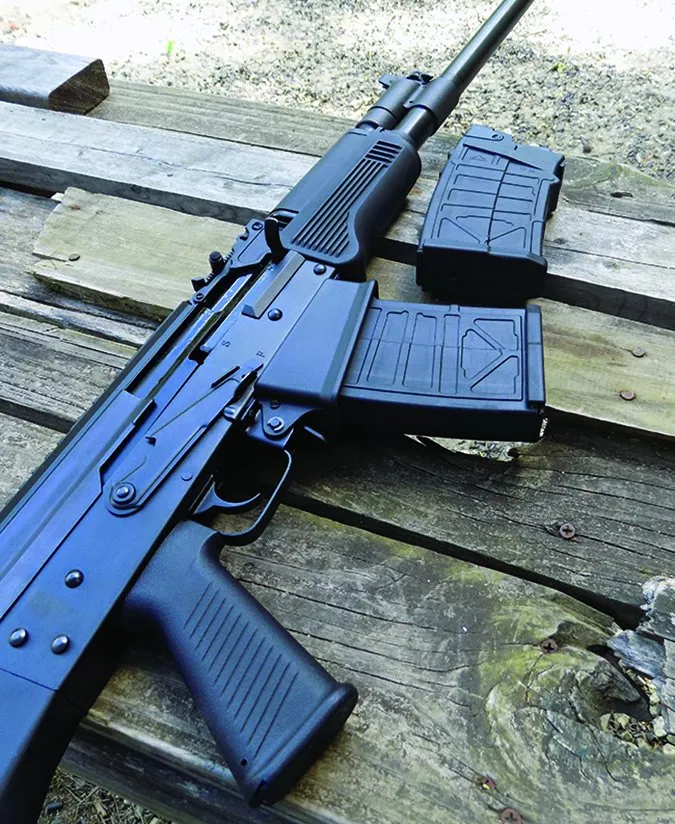
Our Team Said: The JTS is a credible choice for sporting use, which may seem odd to some considering its AK heritage, but those are the facts. For anyone hunting deer or boar with buckshot or slugs, the availability of choke tubes, including Full choke and Super Full turkey-type chokes makes the piece a versatile hunting gun. Slug accuracy is good for a smoothbore shotgun. The receiver rail would allow mounting a red dot or slug scope. We note again the single malfunction and advise potential buyers to be certain to proof a self-loading shotgun with the defense load you intend to use in it.
Written and photographed by Gun Tests Staff, using evaluations from Gun Tests team testers.






